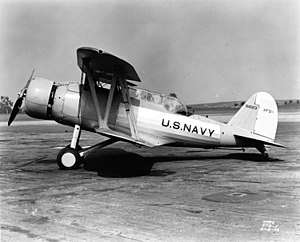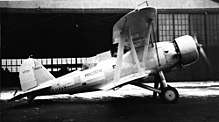Douglas XFD
| XFD | |
|---|---|
 | |
| Role | Fighter |
| National origin | United States |
| Manufacturer | Douglas Aircraft Company |
| First flight | January 1933 |
| Primary user | United States Navy |
| Number built | 1 |
The Douglas XFD was a carrier-based biplane fighter aircraft designed for the United States Navy, and the first fighter to be built by the Douglas Aircraft Company. A victim of changing requirements, no production was undertaken.
Design and development
The XFD was designed to the U.S. Navy's Bureau of Aeronautics (BuAer) Specification No. 311, requesting a carrier-based two-seater biplane fighter.[1] On June 30, 1932, the Navy ordered the XFD, Vought XF3U, and Curtiss XF12C for testing.[2]
The first naval fighter designed by Douglas Aircraft,[3] the XFD was constructed of metal, with a fabric outer covering. The crew sat in tandem in a single bay, enclosed by a long canopy. It had fixed landing gear with a tailwheel. It was designed to be armed with two .30 in (7.6 mm) machine guns, one fixed in the cowling and the other on a flexible mount for the observer, and a 500-pound (230 kg) cound be carried.[4] Powered was supplied by a Pratt & Whitney R-1535 Twin Wasp Junior radial engine.[4]
Operational history
The XFD-1 prototype first flew in January 1933;[2] it was delivered to the U.S. Navy for trials at Naval Air Station Anacostia in June 1933, within four days of the delivery of the Vought XF3U-1;[4] evaluations of the types were undertaken between June 18, 1933 and August 14, 1934.[2] While the XFD-1's performance was considered to be acceptable, the U.S. Navy's operational requirements were already changing to see the two-seat fighter concept falling out of favor, the scout bomber being considered more useful for the Navy's needs, and accordingly after the end of the XFD-1's flight trials no further orders were placed for the type.[4]
Specifications

Data from Angelucci 1987[2], Johnson 2011[4]
General characteristics
- Crew: Two (pilot and observer)
- Length: 25 ft 4 in (7.72 m)
- Wingspan: 31 ft 6 in (9.60 m)
- Height: 25 ft 4 in (7.72 m)
- Wing area: 295 sq ft (27.4 m2)
- Empty weight: 3,227 lb (1,464 kg)
- Gross weight: 5,000 lb (2,268 kg)
- Powerplant: 1 × Pratt & Whitney R-1535-64 14-cylinder air-cooled radial engine, 700 hp (520 kW)
- Propellers: 2-bladed Hamilton Standard
Performance
- Maximum speed: 204 mph (328 km/h; 177 kn)
- Cruise speed: 170 mph (274 km/h; 148 kn)
- Combat range: 576 mi (501 nmi; 927 km)
- Service ceiling: 23,700 ft (7,200 m)
- Rate of climb: 1,670 ft/min (8.5 m/s)
Armament
- Guns: 1 x .30-caliber machine gun, fixed forwards-firing cowl mounting
1 x .30-caliber machine gun, flexible mounting in rear cockpit - Bombs: 500 pounds (230 kg) external
See also
| Wikimedia Commons has media related to Douglas XFD. |
Aircraft of comparable role, configuration and era
Related lists
References
Citations
Bibliography
- Angelucci, Enzo (1987). The American Fighter from 1917 to the present. New York: Orion Books.
- Johnson, E.R. (2011). United States Naval Aviation, 1919-1941. Jefferson, NC: McFarland & Company. ISBN 978-0-7864-4550-9.
- Pattillo, Donald (2001). Pushing the Envelope: The American Aircraft Industry. Ann Arbor, MI: University of Michigan Press. ISBN 0-472-10869-7.
- Yenne, Bill (1985). McDonnell Douglas: Tale of Two Giants. New York: Crescent Books. ISBN 978-0-5174-4287-6.